Scientists in Spain have found the fossilized remains of one of the largest animals ever to walk the earth, a gargantuan plant-eating dinosaur up to 125 feet (38 meters) long and weighing as much as seven elephants.
Turiasaurus riodevensis, named for the region and village in Spain where it was found, lived about 145 million years ago and was a sauropod, that familiar kind of dinosaur with a long neck, long tail and massive body that walked on four stout legs.
It is the largest dinosaur ever found in Europe. Previous dinosaurs of this scale have been found mostly in the Americas and Africa.
Other well-known sauropods include Apatosaurus (formerly known as Brontosaurus), Brachiosaurus and Diplodocus. This one is emblematic of a previously unrecognized branch of European sauropod evolution, the scientists said. Sauropods are the largest land animals in Earth’s history.
“This discovery is the dream of a paleontologist,” Luis Alcala of Fundacion Conjunto Paleontologico de Teruel-Dinopolis in Teruel, Spain, said by e-mail. “Really, I’m not dreaming?”
Alcala and colleagues Rafael Royo-Torres and Alberto Cobos describe Turiasaurus on Thursday in the journal Science.
From Jurassic to Cretaceous
The dinosaur came from a time right at the boundary between the latter two periods of the Age of Dinosaurs, the Jurassic and Cretaceous. Relatively little has been known about European dinosaurs dating from then.

Scientists believe Turiasaurus spent its days munching plants in an area close to the shoreline of the ancient Tethys Sea, forerunner of the Mediterranean Sea.
The first bones were found by Cobos and Royo-Torres in an abandoned wheat field near the village of Riodeva in northeastern Spain in May 2003, Alcala said.
Alcala said Turiasaurus weighed between 40 and 48 metric tons and was between 118 and 125 feet (36 and 38 metres) long -- longer than an NBA basketball court. By comparison, Tyrannosaurus rex was about 45 feet long (13.7 metres) and weighed 6 tons.
The humerus, the bone in the front leg that extends from shoulder to elbow, was as big as a full-grown man.
‘Tremendously large’
Turiasaurus rivals the size of the largest known dinosaurs, all sauropods, and its remains were more complete than those of many of them. These include the African giant Paralititan, Seismosaurus in North America and Argentinosaurus and Puertasaurus in South America.

“It’s a tremendously large animal, not quite to the scale of the ‘land whales,’ things like Argentinosaurus and Puertasaurus or Sauroposeidon. But it’s pretty darned big,” said Thomas Holtz, a dinosaur expert at the University of Maryland who was not involved in the research.
“This is the first real super-giant from Europe,” Holtz said.
Other fossils found at the site indicated Turiasaurus lived alongside other dinosaurs, including biped meat eaters, other sauropods and plant eaters similar to the armored Stegosaurus, as well as turtles and crocodilelike reptiles.
The researchers said Turiasaurus was more primitive from an evolutionary perspective than other known giant sauropods.
The team found 70 pieces of the fossilized remains representing about a quarter of its skeleton, including fragments of the skull, leg, back, toes, ribs, shoulder blade and teeth.
Finding most of the key parts — the only vital missing piece was the pelvic girdle — allowed them to ascertain its dimensions and appearance.
